The Waterford Foundation owns and maintains 11 historic buildings in the National Historic Landmark – Schooley Mill Barn, Red Barn, the Forge, Second Street School, Chair Factory, Corner Store, Bond St. Barn, Bond St. Ice House, John Wesley Church, the Mill, and the Old School. Read more about each historic property below.
Bond Street Barn, Ice House, and Tanyard, Corner of Main and Liggett Streets
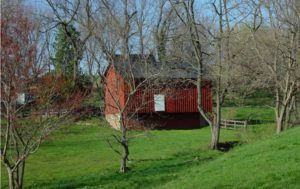 For most of the 19th century the site was a part of a tannery operation owned by Quaker Asa Bond. Lower Tannery Branch trickles through the site of Waterford’s 19th-century tanyard. (An 18th-century predecessor was located a bit upstream, closer to Bond Street.) In the early 1800s the tannery was owned by Quakers Asa Moore and Thomas Phillips. Fellow Quaker Asa M. Bond purchased the business in 1833. The tannery ceased operating within a few years of Bond’s death in 1878, undercut by the extension of the railroad to Paeonian Springs in 1870, which brought in cheaper leather. The tannery included a residence for workers fronting on Main Street and a large processing and storage building. The later boundary wall was built from the latter’s stones. Barely visible in the meadow beside the stream are the pits in which hides were soaked.
For most of the 19th century the site was a part of a tannery operation owned by Quaker Asa Bond. Lower Tannery Branch trickles through the site of Waterford’s 19th-century tanyard. (An 18th-century predecessor was located a bit upstream, closer to Bond Street.) In the early 1800s the tannery was owned by Quakers Asa Moore and Thomas Phillips. Fellow Quaker Asa M. Bond purchased the business in 1833. The tannery ceased operating within a few years of Bond’s death in 1878, undercut by the extension of the railroad to Paeonian Springs in 1870, which brought in cheaper leather. The tannery included a residence for workers fronting on Main Street and a large processing and storage building. The later boundary wall was built from the latter’s stones. Barely visible in the meadow beside the stream are the pits in which hides were soaked.
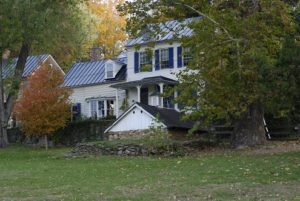 In 1894 Dr. B. L. Rex bought the property and the Bond family house across the road (40132 Bond Street). He tore down the old tan house and used the stone to fence the lot. Circa 1908 Waterford farmer and butcher Ernest L. James acquired the property and built the bank barn. His neighbor, master carpenter Jacob E. “Eb” Divine, may have done the work. The barn stored fodder, farm vehicles and equipment on the upper level, and livestock below. Still penciled on the inside of a door are James’s notes detailing livestock he owned. Mr. James died in 1947: his daughter, Eleanor, continued to live in the house across the road for all of her 81 years. After she died in 1986, the Foundation bought the property from her estate. The barn has since been used by numerous craft demonstrators during the Waterford Fair. The “Apple Pie Ridge” design of a local quilt was recently added as part of Loudoun County’s Quilt Trail.
In 1894 Dr. B. L. Rex bought the property and the Bond family house across the road (40132 Bond Street). He tore down the old tan house and used the stone to fence the lot. Circa 1908 Waterford farmer and butcher Ernest L. James acquired the property and built the bank barn. His neighbor, master carpenter Jacob E. “Eb” Divine, may have done the work. The barn stored fodder, farm vehicles and equipment on the upper level, and livestock below. Still penciled on the inside of a door are James’s notes detailing livestock he owned. Mr. James died in 1947: his daughter, Eleanor, continued to live in the house across the road for all of her 81 years. After she died in 1986, the Foundation bought the property from her estate. The barn has since been used by numerous craft demonstrators during the Waterford Fair. The “Apple Pie Ridge” design of a local quilt was recently added as part of Loudoun County’s Quilt Trail.
Lewis N. Hough Chair Factory, 15502 Second Street
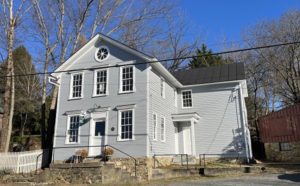 This structure, formerly known as the Hardware Store, housed Lewis N. Hough’s chair manufacturing business from sometime prior to 1875 to about 1895. Hough (1829-1900) expanded his business to include undertaking, making caskets and coffins. His son-in-law, Lemuel P. Smith, later took over the undertaking business. For many years the town council used the upstairs as meeting space. Around 1936, Smith sold the building to Arthur Hawes, who operated a grocery store here. John Rollison ran a hardware store/gas station/barber shop from 1946 until his death in 1986. The Waterford Foundation purchased the building in the 1960s (giving Mr. Rollison life-time occupancy) and it now houses two artist’s studios.
This structure, formerly known as the Hardware Store, housed Lewis N. Hough’s chair manufacturing business from sometime prior to 1875 to about 1895. Hough (1829-1900) expanded his business to include undertaking, making caskets and coffins. His son-in-law, Lemuel P. Smith, later took over the undertaking business. For many years the town council used the upstairs as meeting space. Around 1936, Smith sold the building to Arthur Hawes, who operated a grocery store here. John Rollison ran a hardware store/gas station/barber shop from 1946 until his death in 1986. The Waterford Foundation purchased the building in the 1960s (giving Mr. Rollison life-time occupancy) and it now houses two artist’s studios.
Corner Store, 40183 Main Street
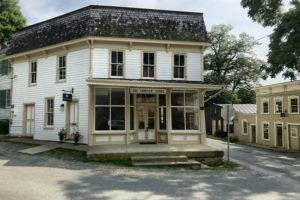 The Corner Store sits literally atop a small creek—the Town Branch—and occupies a strategic location at the intersection of Waterford’s main streets. The present building, erected about 1900, replaced a smaller store built of logs and covered with weatherboard. Note the unusual shape of the building to fit it onto the triangular site. The Waterford Foundation renovated the Corner Store in the early 1990s for use as office space; when the Foundation moved to the renovated Old School in 2012-13, the ground floor of the building again became a store, featuring local crafts and foods, as well as exhibit space. The second floor houses a realty office.
The Corner Store sits literally atop a small creek—the Town Branch—and occupies a strategic location at the intersection of Waterford’s main streets. The present building, erected about 1900, replaced a smaller store built of logs and covered with weatherboard. Note the unusual shape of the building to fit it onto the triangular site. The Waterford Foundation renovated the Corner Store in the early 1990s for use as office space; when the Foundation moved to the renovated Old School in 2012-13, the ground floor of the building again became a store, featuring local crafts and foods, as well as exhibit space. The second floor houses a realty office.
The Forge, 15484 Second Street
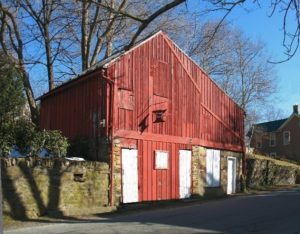 The land on which the forge sits was once part of 40193 Main Street, the log house on the Big Hill. This board-and-batten structure was most likely constructed to serve that house as a barn. The exterior indicates three stages of construction. Today the Waterford Foundation uses it to demonstrate blacksmith and gunsmith work during the annual fair.
The land on which the forge sits was once part of 40193 Main Street, the log house on the Big Hill. This board-and-batten structure was most likely constructed to serve that house as a barn. The exterior indicates three stages of construction. Today the Waterford Foundation uses it to demonstrate blacksmith and gunsmith work during the annual fair.
John Wesley Community Church, 40125 Bond Street
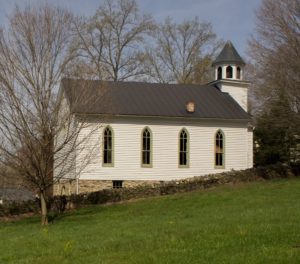 Between 1830 and the Civil War, about 20 free Black families lived in Waterford, representing about one-fifth to one-quarter of the town’s population. Many of free African American men worked as skilled laborers, including as blacksmiths and mechanics and in other crafts. Bronwen C. and John M. Souders wrote about the experiences of the African American community in their book, A Rock in a Weary Land, A Shelter in a Time of Storm. They tell of the work of J.T. Moten, Pastor of the Waterford Circuit, who led efforts to raise money to buy land and build a church. By 1886 they had raised $127.10 and bought a fifth of an acre at the corner of Bond and Liggett Streets from Mary Jane Hough, a Quaker widow.
Between 1830 and the Civil War, about 20 free Black families lived in Waterford, representing about one-fifth to one-quarter of the town’s population. Many of free African American men worked as skilled laborers, including as blacksmiths and mechanics and in other crafts. Bronwen C. and John M. Souders wrote about the experiences of the African American community in their book, A Rock in a Weary Land, A Shelter in a Time of Storm. They tell of the work of J.T. Moten, Pastor of the Waterford Circuit, who led efforts to raise money to buy land and build a church. By 1886 they had raised $127.10 and bought a fifth of an acre at the corner of Bond and Liggett Streets from Mary Jane Hough, a Quaker widow.
Most of the work was done by the local African American citizens of Waterford. Because the congregation members worked long days, they had only evenings to do construction work on the church. Tales are told of men working long hours after their full workdays by the light of lanterns held high by the women of the congregation. The community completed the church in 1891. The church had a large, active congregation and was the site of regular social and religious activities, harvest day celebrations, and many weddings and baptisms.
This Gothic Revival structure, built on the site of a former livery stable, greatly enlarged the worship space over that available at the one-room school and church that the congregation had used since 1867. The John Wesley Methodist Church was home to a thriving congregation for over 160 years. Regular services at John Wesley ceased in the 1960s. The Waterford Foundation, in partnership with former members and their descendants, restored the building and eased it against inappropriate change. The Virginia Board of Historic Resources holds a Deed of Easement on the property effective April 20, 2000.
In 1999, former members of the congregation and their children formed a partnership with the Waterford Foundation to ensure that the church would be restored. Before the last church trustee died in 2001, the Foundation agreed to take title of the building. Since taking ownership, the Foundation has worked to restore the church to its original appearance.
The Mill, 40105 Main Street
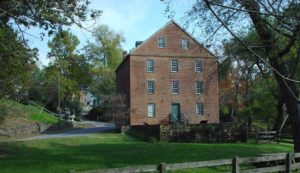 The Waterford Mill stands at the heart of the village of Waterford. The third mill to stand on the site, it was built in 1818 to process the fine wheat produced in the fertile land of Loudoun County. Its builders provided a technologically advanced answer to the demand for high-quality flour shipped around the nation and even to Europe and South America. They adopted the design for an “automated mill” developed by Oliver Evans in the late eighteenth century. The sturdy masonry mill was provided with a large wooden hurst frame, set below the first floor and designed to carry three sets of millstones and their gearing. The frame was intended to separate the mill from the vibrations of the machinery. The mill was equipped with elevators and chutes that carried the grain to be cleaned, stored, and milled and the flour to be processed, cooled, stored, and packed with the aid of the water-powered machinery and with a minimum staff.
The Waterford Mill stands at the heart of the village of Waterford. The third mill to stand on the site, it was built in 1818 to process the fine wheat produced in the fertile land of Loudoun County. Its builders provided a technologically advanced answer to the demand for high-quality flour shipped around the nation and even to Europe and South America. They adopted the design for an “automated mill” developed by Oliver Evans in the late eighteenth century. The sturdy masonry mill was provided with a large wooden hurst frame, set below the first floor and designed to carry three sets of millstones and their gearing. The frame was intended to separate the mill from the vibrations of the machinery. The mill was equipped with elevators and chutes that carried the grain to be cleaned, stored, and milled and the flour to be processed, cooled, stored, and packed with the aid of the water-powered machinery and with a minimum staff.
The Foundation has owned the Mill since 1944 and has undertaken preservation work in 1945, 1983, 1998, and 2009. The millrace, mill pond, and tailrace have been largely filled in. Planned in 2007 and carried out in 2023, a stabilization project was undertaken that will allow the Mill to fulfill its educational mission more fully and welcome a greater number of visitors. Read more about the Waterford Mill Stabilization Project here.
The Old School, 40222 Fairfax Street
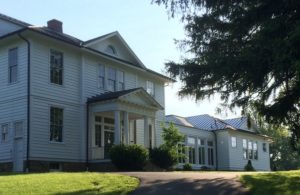 This former elementary and high school opened in 1910, replacing the circa 1880 Waterford Academy that had burned. An auditorium was added at the rear in 1928 but was destroyed by fire in 2007. The Waterford Foundation purchased the property from the Loudoun County School Board in 1966. The school now houses the offices of the Waterford Foundation. The new auditorium (relocated, rebuilt and reopened in 2012), as well as some classrooms are available to rent for weddings and other events.
This former elementary and high school opened in 1910, replacing the circa 1880 Waterford Academy that had burned. An auditorium was added at the rear in 1928 but was destroyed by fire in 2007. The Waterford Foundation purchased the property from the Loudoun County School Board in 1966. The school now houses the offices of the Waterford Foundation. The new auditorium (relocated, rebuilt and reopened in 2012), as well as some classrooms are available to rent for weddings and other events.
The Red Barn, Second Street adjacent to the Waterford Market
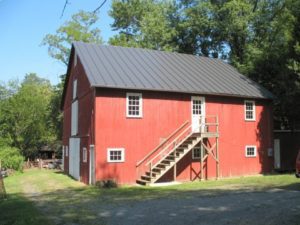 An assortment of stables and barns has occupied this site this site since at least the mid-19th century. The livery business required sheltering of horses and their feed, in addition to space for harness, wagons, and buggies. In August 1907, a fire broke out in one of those buildings and spread rapidly to adjoining structures, threatening to consume much of the town. According to Douglas Myers (1896 1982) a young eye witness, whose father owned the adjoining Tin Shop, “Four stables burned, just back of the livery stable and after the fire was under control all the wash boilers, dish pans, and what have you were left in the streets a reminder that the town was saved. The hero of this occasion was Mr. Albert Shawen, who stayed on top of one of the barns until the hair on his head was burned completely off, and his face and arms scorched.”
An assortment of stables and barns has occupied this site this site since at least the mid-19th century. The livery business required sheltering of horses and their feed, in addition to space for harness, wagons, and buggies. In August 1907, a fire broke out in one of those buildings and spread rapidly to adjoining structures, threatening to consume much of the town. According to Douglas Myers (1896 1982) a young eye witness, whose father owned the adjoining Tin Shop, “Four stables burned, just back of the livery stable and after the fire was under control all the wash boilers, dish pans, and what have you were left in the streets a reminder that the town was saved. The hero of this occasion was Mr. Albert Shawen, who stayed on top of one of the barns until the hair on his head was burned completely off, and his face and arms scorched.”
At that time, the livery stable was owned by Amos Beans and his son, Edgar H. The following year, they hired contractor Arch Simpson and master carpenter Jacob E. “Eb” Divine to build a new barn at a cost of $850. The Waterford Foundation bought that barn from E. H. Beans in 1948 with $500 donated by Ellen (Mrs. Fenton) Fadeley, who owned nearby Rosemont Farm. Both Beans and Fadeley were original directors of the Foundation. After the sixth fair, in October 1949, the organization spent an additional $600 for repairs and improvements. Mrs. Fadeley specified that the Barn was to be used to display and sell artwork during the Fair. Her wish has been honored ever since.
Schooley Mill Barn, Second Street, Behind the Second Street School
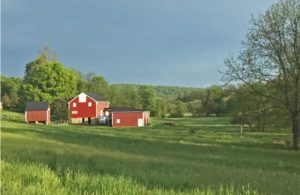 The site began in 1803 as a grist and sawmill complex built by Mahlon Janney. The mill was used to process corn and limestone, freeing up Janney’s primary mill for merchant flour production. After 1840, the mill was owned by John Schooley or his son Milton. It ceased operation in 1920 and was converted into the barn visible today by Edgar Beans. The Foundation leases the barn to a local farmer who grows hay.
The site began in 1803 as a grist and sawmill complex built by Mahlon Janney. The mill was used to process corn and limestone, freeing up Janney’s primary mill for merchant flour production. After 1840, the mill was owned by John Schooley or his son Milton. It ceased operation in 1920 and was converted into the barn visible today by Edgar Beans. The Foundation leases the barn to a local farmer who grows hay.
Second Street School, 15611 Second Street
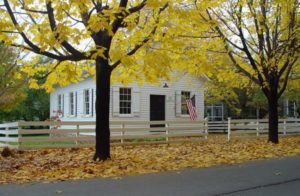 In 1866 Quaker Reuben Schooley (1826-1900) sold this property to the “colored people of Waterford and vicinity.” The local African American population, with financial help from the Quakers, promptly erected a school building they could also use for church functions. Home of the Waterford Foundation’s Second Street School Living History Program since 1984, this is one of the older one room schoolhouses in Loudoun County. Its use as a church was phased out in 1891 after the congregation built John Wesley Methodist-Episcopal Church on Bond Street. The school finally closed its doors in 1957 when schools Waterford’s Black students were bussed to Frederick Douglas school in Leesburg. The Waterford Foundation bought the property in 1977. In 1984 it developed a living-history program that allows Fourth Grade students to experience a typical 1880s school day in a segregated school. That program continues to this day. Read more on our Second Street School page.
In 1866 Quaker Reuben Schooley (1826-1900) sold this property to the “colored people of Waterford and vicinity.” The local African American population, with financial help from the Quakers, promptly erected a school building they could also use for church functions. Home of the Waterford Foundation’s Second Street School Living History Program since 1984, this is one of the older one room schoolhouses in Loudoun County. Its use as a church was phased out in 1891 after the congregation built John Wesley Methodist-Episcopal Church on Bond Street. The school finally closed its doors in 1957 when schools Waterford’s Black students were bussed to Frederick Douglas school in Leesburg. The Waterford Foundation bought the property in 1977. In 1984 it developed a living-history program that allows Fourth Grade students to experience a typical 1880s school day in a segregated school. That program continues to this day. Read more on our Second Street School page.
